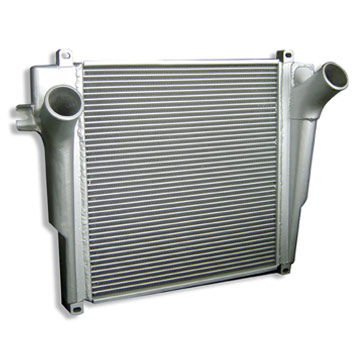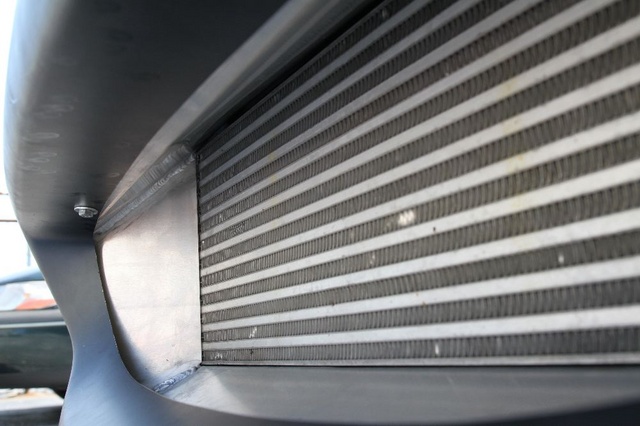| What's Hot! | Products/ Tools | EFI Tuning | Basic Tuning | Advanced Tuning | Chassis Tuning | Advertise with us |
What is an Intercooler?
How to improve your intercoolers efficiency and make more power
Article by: enginebasics.com
An intercooler is just another name for a heat exchanger that is used to cool air that has been compressed by either a Super-Charger or a Turbocharger. The intercooler is placed somewhere in the path of air that flows from the turbo/supercharger to the motor. An intercooler is needed because of the physics of air described in the Ideal Gas Law, that is PV=nRT.
Explaining the ideal gas law as basic as we can, we can say that because pressure and temperature are directly proportional, as you create more pressure with your turbo or supercharger, you produce more heat as well. At first one might think: “who cares how hot the air is that is going in my motor” , but there are two main reasons why this is a bad thing.
1. Hot air is less dense and therefore contains less molecules of oxygen per unit volume. This means less air for the motor in a given stroke and therefore less power produced.
2. Hot air also causes a higher cylinder temperature and therefore can aid in pre-detonation of the combustion cycle causing what we call, detonation.
When intake air pressures are kept at a modest or low boost pressure, an intercooler may not be necessary for your set-up. That being said, a colder denser charge will not only be safer for your motor, but add power as well. With their not being to many things that ad safety and engine longevity as well as power, adding an intercooler to your forced induction set-up is a no brainer.
Gaining Power from an Intercooler
Well as stated above, intercoolers can make are charged air denser so we can fit more in the cylinder, but also they are a HUGE aid in tuning out detonation. We have all seen the gains in torque that can be had by advancing timing a few degree’s, and with a colder air temp, we can help drive off the condition of pre-detonation. While you may not be interested in building a set of detonation cans, check out THIS ARTICLE (link) that talks more about the idea and background of pre-ignition and detonation, and how to better listen for it on your engine.
What are the ways that I can improve my intercooler and get more power?
The most common question when talking about intercoolers is how exactly do I get more power from one? Here are a few steps to follow:
1. Make sure it is seeing the most airflow that it can. Most people put it in the front of the vehicle in the direct path of air and call it good.
For those that REALLY want to gain as much efficiency as possible, be sure to also direct the air through the intercooler and nothing but the intercooler. This is made possible by building a ducting system around the intercooler itself, as seen in the photo above, so that the air has no choice but to pass through it. If you have read enginebasics.com’s article on radiator efficiency you would understand how important the ducting and directing of airflow is for a radiator. Gains of almost 11% efficiency were made just from the ducting of the air. The idea works here as well being that an intercooler is really just a radiator for the air.
2. Size the intercooler properly. A small/thin intercooler will be come heatsoaked fast if it is not sized right for the application. Heat soaked is the idea that you are pushing so much hot air through the intercooler that it just doesn’t have enough surface area, or clean airflow to relive itself of the heat and therefore becomes useless as the temperature of the intercooler is the same temperature as the air passing through it from your turbo or supercharger. Some people use smaller intercoolers to aid in not having a large pressure drop through the intercooler. A pressure drop usually occurs with intercoolers, because of there massive size, or usually because of there terrible flow design. This can be avoided by purchasing a unit that has been well build and constructed. I would argue that when it comes to an intercooler, the bigger the better. Some would say this is pointless and just aids to the pressure drop, but the drop in pressure is SO MINOR on a larger intercooler that I personally think the gains out weight the losses.
3. Adding an external cooling system to aid in cooling the intercooler. Here at enginebasics.com we have written several articles about some aftermarket ways and do it yourself ( DIY ) ways of boosting your intercoolers performance.
a. Spraying the intercooler with water
b. Adding a Co2 freezing system
To give you an idea of the gains that can be had. At a local dyno shoot out of Mitsubishi Evolutions, Evo , Vs Subaru Impressa WRX and STI, one of the participants dyno’d 413 whp. Then some buddies of his grabbed a couple snowballs from the snow outside and tossed them on the intercooler. The car then did another pull and I watched in amazement as those snowballs melted before my eyes in just the 8-10 seconds the pull lasted. That gives you an idea of the amount of heat an intercooler is pulling out of the system. The results: 448 whp , a gain of 35 whp from a couple of snowballs. You can guess what happened next. The buddies of this guy then ran outside again this time shoving snow all into and around the whole intercooler. He does another pull and this time measures 471 whp, a gain of 58 whp. Now imagine being able to tune around those colder inlet temperatures and being able to increase the timing a bit. Even further gains could be realized.
4. To read a great article on the actual science and engineering that goes into making a more efficient intercooler be sure to check out the: Intercooler Efficency Test.
Different types of intercoolers
There are two main types of intercoolers on the market:
1. Air to Air
2. Air to Water
Enginebasics.com has written an article discussing the pro's and con's of each set-up. If interested in learning which intercooler might be right for your car, CLICK THIS LINK.
To find out more on setting up a very efficient Air to water Intercooler, CLICK THIS LINK.
If your currious where to get good deals on intercoolers try some of the links below:
Summary
By now I’m sure you realize the importance of a good, and efficient intercooler. But hopefully this article also gave you some idea’s on how to improve your current intercooler set-up. There are HUGE gains that can be realized here as long as you take some time to plan and execute a proper intercooler set up.
ATTENTION READER:
If you enjoyed the information and article you just read be sure to check out our newly released book with even more exciting photo's and information:How to Turbocharge and Tune your Engine

Want to know more about your particular Make and Model vehicle? All of these vehicles are covered in the tech, maintenance and repair articles found above. Enginebasics is the wiki or wikipedia of car part, repair, how to and tuning information. Let us be the class 101 for your automotive learning.
| Ford | General Motors GM | Pontiac | Jaguar | Land Rover | Nissan |
| Toyota | Honda | Lexus | Acura | Lotus | Scion |
| Infinity | BMW | Mercedes | Mitsubishi | Ferrari | Maserati |
| Lamborghini | Volks Wagen VW | Saab | Audi | Hyundai | Kia |
| Subaru | Mazda | Chevy | Volvo | Caddilac | Dodge |
| Chrylser | Daewoo | Porsche | Mercury | Freightliner | MG |
Individual Models
| Ford Mustang | Mitsubishi Eclipse | Mitsubishi Evo | Subaru WRX / STI | Dodge Viper | Chevrolet Corvette |
| Nissan Skyline | Honda S2000 | Nissan 350z | Toyota Supra | Chevy Camaro | Lotus Elise Exige |
| Honda Civic | VW Golf | Dodge SRT-4 | Eagle Talon | Acura Integra | BMW M3 |
| Nissan 240sx | Porsche 911 | Acura NSX | Honda Accord | Toyota Camry | Toyota MR2 |
| VW R32 | Dodge Truck | Mazda Rx7 | VW Jetta | Sand Buggy | Nissan Sentra |
For the latest Automotive news and stories visit the websites below |
Our feature Build: An AWD V6 Civic






